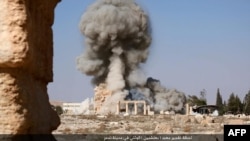Photos posted online by Islamic State on Tuesday claim to show the destruction of a 2,000-year-old temple at the Syrian world heritage site of Palmyra earlier this week.
In the series of images, several men carry barrels into the Roman-era Baal Shamin temple, lining the base and placing the containers connected by blue wire on columns.
Other photos show a cloud of smoke and debris, and dust-covered hunks of rubble, presumably in the aftermath of Sunday's explosion.
UNESCO called the temple's destruction a war crime.
It was part of the archeological complex at Palmyra, a UNESCO world heritage site in central Syria.
Islamic State seized the town, including the ruins of the ancient city, in May.
Last week, IS militants beheaded Khaled Asaad, the 82-year-old archeologist and former head of antiquities in Palmyra who spent decades preserving the site.
The group has targeted other cultural sites in Syria and Iraq under the pretext of destroying pre-Islamic artifacts. But the group is also reported to sell off looted art as an additional revenue stream.










